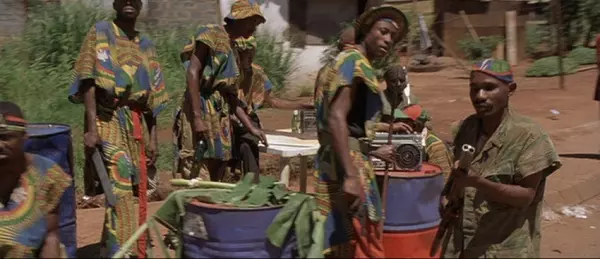I’m neither an expert nor an authority on both topics and groups, but what is certain is what these groups stand for and what they represent. The role of interahamwe in the Rwandan genocide in 1994 is indisputable. As I have mentioned above The Interahamwe (also known as the Interahamwe) militia played a major role in the Rwandan genocide of 1994 and early in 1992.
Some political organizations affiliated with the former President Habyarimana formed two militias—the Interahamwe (“Those Who Attack Together”) and the Impuzamugambi (“Those Who Have the Same Goal”). Trained and supplied by the Rwandan army, the militias were involved in the killing of more than 2,000 civilians, mostly Tutsi [in 1992]. They would play a central role in the atrocities that commanded the world’s attention in 1994″ (USIP Jan. 1995).
According to Philip Gourevitch, author of a study of the Rwandan genocide, the Interahamwe militia “had its genesis in soccer fan clubs sponsored by leaders of the MRND” (the National Revolutionary Movement for Development, party of President Habyarimana) “and the akazu” (“the core of the concentric webs of political, economic, and military muscle and patronage that came to be known as Hutu Power”) (Gourevitch 1998, 83 & 91).
The central role of the Interahamwe militia in the planning of the 1994 genocide was made clear in a fax sent by the head of the United Nations Mission in Rwanda (UNAMIR), Brigadier-General Romeo Dallaire, to his superiors at U.N. headquarters in New York in January 1994, three months prior to the start of the genocide. The fax described information from an informant, who “is a top level trainer in the cadre of Interhamwe-armed militia of MRND” (Frontline 26 Jan. 1999). The informant said he had, “. . . trained 1700 men in military camps outside the capital. The 1700 are scattered in groups of 40 throughout Kigali . . . Since UNAMIR mandate he has been ordered to register all Tutsi in Kigali. He suspects it is for their extermination. Example he gave was that in 20 minutes his personnel could kill up to 1000 Tutsi” (Frontline 26 Jan. 1999).
Similarly in Uganda in 1980s, after the contested elections in which the former President Milton Obote became victorious, and President Museveni went to the Bush to challenge what he called stolen election, Millton Obote was busy building the Youths, a notorious Militia like that of Interahamwe in Rwanda.
They killed people and to certain extend they were more powerful than the security forces. After the fall of Milton Obote most of the Militias found themselves on the wrong side of history and they paid in the currency that they used for their countrymen. But what is clearer is that when leaders create these groups they don’t tell people that they will be bad groups, บาคาร่า โบนัส they call them good names and become an eye of the government of the day.
Obviously (Interahamwe and Intore) groups were and are sponsored by the government, they preach the gospel of the government and they represent the symbol of the government which is their respective Parties, MRND and RPF respectively. At his trial the former Prime Minister Jean Kambanda admitted that he issued a directive on June 8 [1994] that “encouraged and reinforced the interahamwe who were committing the mass killings of the Tutsi civilian population . . . [By] this directive [he admitted] the government assumed the responsibility for the actions of the interahamwe” (OAU May 2000).
The role of the Interahamwe militia was not only carrying out atrocities but also encouraging or forcing ordinary citizens to become involved in the slaughter of innocent citizens. Unfortunately the leader of Intore in Rwanda is a man who is rumored to have had a hand in establishing the Interahamwe Militia and one of the proprietors of the notorious radio RTLM. It is therefore interesting that, the government of the day is making the same mistakes of creating the same groups they fought during genocide in Rwanda. In this article I will argue that it’s a change of the label but the content in the bottle is the same.
Good names for wrong cause!
Many people will agree with me that, both names Interahamwe and Intore are good names found in our Kinyarwanda dialects and I think that’s why governments choose them to sell their brand, however, governments use the youths to dispense the atrocities in the disguise of good intentions. It takes time for the international community and some people to realize the true colors of those groups. Both groups will use government money and facilities; the government recruits the youths because the youths are vulnerable for jobs and lack experience in all aspects of political life. But in the end the youths pay a heavy price when these leaders expire or are forced to expire.
As I have mentioned above, all Rwandans know what the Intore means and what it means in the Rwandan culture, this was a symbol of the King and for those who were born after the Monarchy, Intore are used as a dancing group, they entertain people and look like a warrior dance very spectacular for the way they entertain Rwandans and foreigners.
In Rwandan if you mention Interahamwe, the people around you will gaze and may think that the killer machine is back on the Rwandan soil. The word Interahamwe is a curse both internationally and in Rwanda, but will the same word Intore be cursed in the near future? Will the leaders of the day not use Intore in wrong things? Let’s pray for those who are members of Intore to learn from their predecessor Interahamwe and draw the line between working for the people and the government of the day. Indeed, our leaders should not use our youths in wrong things, because Rwanda’s future lies in the hands of the youths. Let’s wait, time will tell.
Jacqueline Umurungi
Brussels.
.

